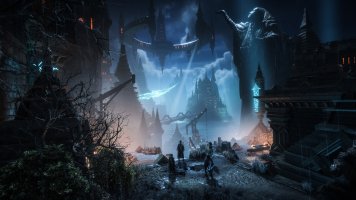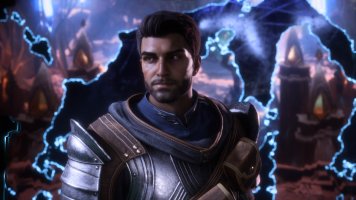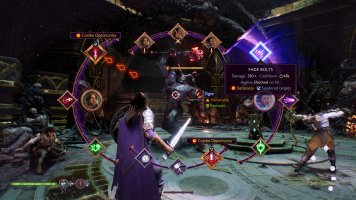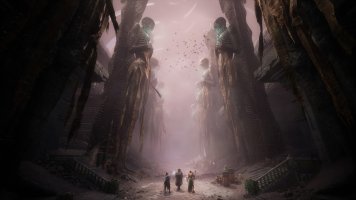General Information
The main character, whose background and abilities are customizable, is thrust into a world teetering on the brink of chaos. The Veil, a metaphysical barrier separating the world of mortals from the realm of spirits and demons, is weakening at an alarming rate. As the Veilguard, players must navigate political intrigue, ancient magic, and personal relationships while racing against time to prevent a catastrophic merger of realms.
Key characters include Elara, a brilliant but controversial mage researcher; Korrigan, a dwarven artificer with a penchant for explosive solutions; and Fenris, a returning character from Dragon Age II, whose unique abilities prove crucial in understanding the nature of the Veil.
Gameplay Mechanics
"The Veilguard" builds upon the foundations laid by its predecessors while introducing innovative mechanics that breathe new life into the series. The combat system retains the strategic depth fans have come to expect, allowing players to pause and issue commands or engage in real-time battles. However, the introduction of the "Veil Manipulation" system adds a new layer of complexity and excitement to encounters.
Veil Manipulation allows players to temporarily thin or thicken the Veil in localized areas, affecting both allies and enemies. Thinning the Veil might enhance magical abilities but also increase the risk of demon possession, while thickening it could weaken spells but provide protection against supernatural threats. This system encourages creative problem-solving both in and out of combat, as manipulating the Veil becomes crucial for puzzle-solving and exploration.
Character development has been overhauled, introducing a flexible class system that allows for more diverse builds. The traditional warrior, rogue, and mage archetypes serve as starting points, but players can now blend abilities from different specializations, creating truly unique characters. This system supports a wide range of playstyles and enhances replayability.
Exploration has been significantly expanded, with larger, more interactive environments. The game world feels more alive than ever, with dynamic events and a day-night cycle that meaningfully impacts gameplay. Side quests are more organically integrated into the main narrative, making them feel less like busywork and more like essential parts of the story.
Graphics and Sound
Visually, "The Veilguard" is a stunning achievement. The game leverages current-gen hardware to create breathtakingly detailed environments, from sprawling cities to otherworldly Fade landscapes. Character models and animations have seen a marked improvement, with facial expressions and body language conveying emotions more convincingly than ever before.
The art direction deserves special praise for its imaginative interpretation of familiar Dragon Age elements. The visual representation of Veil manipulation is particularly noteworthy, with subtle distortions and ethereal effects that enhance the game's mystical atmosphere without becoming overbearing.
Aurally, the game is equally impressive. The soundtrack, composed by veteran Trevor Morris, perfectly captures the epic scale and emotional nuances of the story. Dynamic music shifts seamlessly to match the on-screen action, heightening tension during combat and evoking wonder during exploration.
Voice acting is consistently excellent across the board, with standout performances from both returning cast members and newcomers. The ambient sound design is rich and immersive, bringing the world of Thedas to life with subtle environmental cues and magical effects.
Storytelling
"The Veilguard" continues BioWare's tradition of strong narrative focus, presenting a complex, multi-layered story that tackles themes of power, responsibility, and the nature of reality itself. The main plot is compelling, with well-paced revelations and genuine surprises that keep players engaged throughout the 40+ hour campaign.
Where the game truly shines is in its character development and interpersonal relationships. Companions are deeply fleshed out, each with their own motivations, fears, and growth arcs that intertwine meaningfully with the main story. The dialogue system has been refined, offering more nuanced responses that allow for greater role-playing depth.
Player choices have significant and far-reaching consequences, affecting not only the immediate outcome of quests but also shaping the political landscape of Thedas and the personal fates of key characters. The game does an admirable job of making these choices feel weighty and morally ambiguous, often forcing players to grapple with difficult decisions that have no clear "right" answer.
The integration of lore from previous games and expanded universe materials is handled deftly, providing longtime fans with satisfying connections and payoffs while remaining accessible to newcomers. Optional codex entries and environmental storytelling reward curious players with additional depth and context.
Comparative Analysis
Compared to its predecessors, "The Veilguard" represents a significant step forward for the Dragon Age series. It successfully addresses many of the criticisms leveled at "Dragon Age: Inquisition," particularly regarding the open-world structure. While "The Veilguard" retains large, explorable areas, they feel more focused and purposeful, avoiding the "MMO-like" fetch quest bloat that some found tedious in "Inquisition."
The return to a more personal story, reminiscent of "Dragon Age II," is welcome, but "The Veilguard" manages to balance this intimate focus with the epic scale that made "Origins" and "Inquisition" so memorable. The result is a narrative that feels both grand and grounded, with stakes that are simultaneously personal and world-changing.
Combat has evolved to be more dynamic and engaging than in previous entries, with the Veil Manipulation system adding a tactical layer that was somewhat lacking in "Inquisition." The more flexible character progression system also addresses complaints about class restrictions in earlier games, allowing for greater build diversity and experimentation.
Technically, "The Veilguard" is leaps and bounds ahead of its predecessors, fully utilizing modern hardware to create a visually stunning and seamlessly loading world. Load times, a significant issue in previous titles, have been all but eliminated, contributing to a more immersive experience.
Final Thoughts
Dragon Age: The Veilguard is a triumphant return to form for BioWare and a new high watermark for the series. It successfully builds upon the strengths of its predecessors while addressing their weaknesses, resulting in a game that feels both familiar and fresh. The compelling narrative, refined gameplay mechanics, and stunning presentation come together to create an RPG experience that is both emotionally engaging and mechanically satisfying.
While some players might find the complexity of the Veil Manipulation system initially overwhelming, and others may yearn for the simpler, more focused structure of "Origins," these are minor quibbles in the face of the game's overwhelming strengths.
For fans of the series, "The Veilguard" is an essential experience that pushes the overarching narrative of Thedas in exciting new directions. For newcomers, it serves as an excellent entry point, offering a self-contained story that nonetheless enriches the broader Dragon Age mythos.
Dragon Age: The Veilguard is not just a great Dragon Age game, but a standout RPG in its own right. It comes highly recommended for fans of the genre and anyone looking for a rich, immersive gaming experience. BioWare has once again proven why they are masters of the RPG craft, delivering a game that will be remembered and discussed for years to come.
Score: 9.5/10






